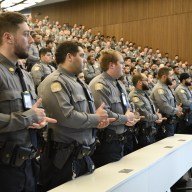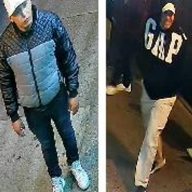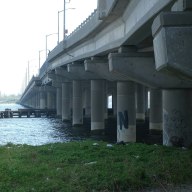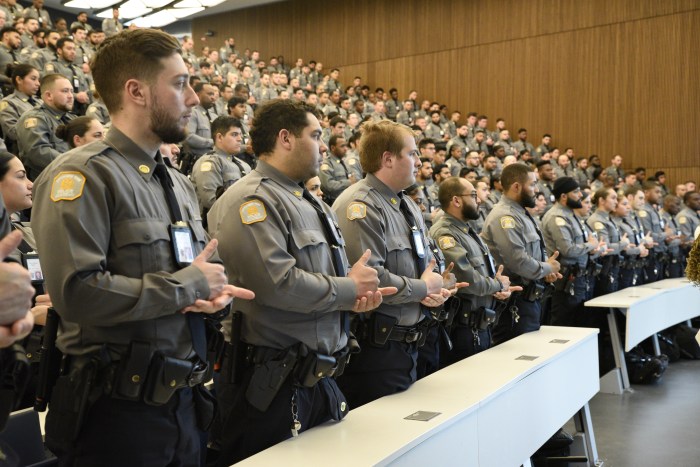By Michèle De Meglio By Gary Buiso
With tears in their eyes and yearbooks in their hands, teachers and students at St. Thomas Aquinas School said goodbye for the final time. Open for nearly 80 years at 1501 Hendrickson Street, the school is one of 22 the Diocese of Brooklyn has ordered to close their doors for good. While the last day of the school year is generally a joyous occasion for students, children – as well as educators – leaving St. Thomas were consumed by emotion. As seventh-grader Tyesha Lespinasse got her autograph book signed by her favorite math teacher, a St. Thomas fixture wished her friends well. Working as a crossing guard in front of the school for 26 years, Marjorie Corda was bombarded by teachers and children who presented her with presents, flowers and pink cotton candy. St. Thomas’ students and staff have had several months to prepare for the closing of the school. In February, the Diocese of Brooklyn announced plans to close 17 of the borough’s Catholic schools and nine others in Queens. Citing declining enrollment and an inability to cover the rising cost of running the schools, the diocese said it could no longer afford to keep the schools open. The diocese had explained that enrollment at all Catholic schools in Brooklyn and Queens has decreased by 11,000 students in the last five years. Last year alone, the diocese said it provided $7 million in assistance to schools whose revenues failed to meet expenses. Parents fought the closings by staging protests and encouraging their local elected officials to lobby for the schools to remain operational. Several schools were given an opportunity to stay open. Shortly after the closings were announced, many schools were given one month to create a business plan outlining how they would support themselves financially over the next three to five years without financial assistance from the diocese. St. Finbar’s School in Bath Beach, Sacred Hearts-St. Stephen’s School in Carroll Gardens, St. Virgilius School in Broad Channel, Queens, and St. Stanislaus Bishop and Martyr School in Ozone Park, Queens, were the only schools to submit business plans, all of which were approved. St. Thomas did not submit a business plan. Diocese Spokesperson Frank DeRosa explained that, in the fall, many of St. Thomas’ students will attend classes at a new regional site to be located at Our Lady Help of Christians School, 1340 East 29th Street. “At this point, there are at least 100 of the St. Thomas Aquinas students that are going to be going there,” he said. The future use of St. Thomas’ school building remains up in the air. “There has been no decision made at this point,” DeRosa said. Yes Virginia, there is a halfway house on McDonald Avenue—for now. The two-family home at 2257 McDonald, called a “sober house” by Bridge Back to Life Center Inc., the organization operating it, is currently accommodating approximately 15 people who are recovering from chemical dependency. But its time there might be brief, according to a state lawmaker who said a “conversation” he had with the building owner and the facility’s clinical director has prompted an imminent departure. “It’s obviously a square peg in a round hole,” Senator Carl Kruger said. Kruger said he was initially contacted by nearby Magen David Yeshiva, which objected to the home’s presence, which was at first only supported by conjecture. Then, the state lawmaker said, he recently spoke to a person delivering a large number of mattresses to the home, confirming a rumor that a social services type facility would be arriving. Kruger said that property owner Egal Shasho “understood that this was a bad business decision.” In a June 10 letter to Magen David Yeshiva, Shasho, of Mill Island based American Real Estate LLC, writes that he will provide Bridge Back to Life, “two new locations that are currently in final stage completion [sic].” “Within two weeks maximum, 2257 McDonald Ave. will be delivered to me vacant,” the property owner explains. Kruger said he had a “tough conversation” with the clinical director, explaining “that they went about it all wrong.” He said it was “totally inappropriate”’ for the organization to move into the home, with nary a word to anyone. “The bottom line is that they are leaving that location,” Kruger said. When a story about the home ran last week, no information about the facility could be found at the local community board or through the city’s Department of Buildings. That’s because, under the law, according to the head of the organization, no notification was required. Gary Butchen, the executive director of Bridge Back to Life, a private network of state licensed, outpatient substance abuse treatment centers, said he was hopeful an amicable solution could be reached soon. He confirmed that the building owner has agreed to look at other properties he owns that could be more suitable the organization’s needs. “I’m considering it, but we haven’t committed to anything yet,” he said. Butchen stressed that the home was for people already “clean and sober.” The organization has a network of recovery homes, where recovering patients may stay after treatment. The McDonald Avenue site is not a treatment center, and therefore did not require any public notice, Butchen said. Such residences are protected under federal law, including the Fair Housing Act, Butchen said. No one in the home has been convicted of a felony, “and certainly never any sexual offenses.” Any brushes with the law, he said, have been misdemeanor offenses. Butchen said the conversation with Kruger, “did not go well.” He said he heard that Kruger spoke to Larry Litras, who work’s at the organization’s Remsen Street treatment center. “There was not much of a conversation. I heard Kruger basically tried to read us the riot act. He [Litras] said he felt Kruger stepped over the line, and in many ways, was intimidating,” the executive director continued. “If it’s more advantageous for my people than we will move,” Butchen said. “But I’m certainly not going to bend because I feel I am bullied by a state senator,” he said. “We haven’t done anything to warrant being run out of town,” he added. Assembly member William Colton initially said he found no evidence of the facility—which he objected to at this location anyway. “If they want to insert something like this in the community without notifying the neighborhood…they will get a reaction,” he said. Butchen’s organization has been in existence for over 20 years; treatment centers are located in Bay Ridge, Downtown Brooklyn and Coney Island. Residents typically stay up to a year in any of the residences, Butchen said. The average stay 6-9 months in duration, he added. There are house managers on site 24 hours/seven days a week he said, but no security cameras. “We try and create a sense of a domicile, not a bank,” he responded when asked about cameras. Butchen said he understood that local residents are initially, “frightened by our clients.” “We are not importing drug addicts from Kansas. These are former Brooklyn residents that need transitional housing.”





























